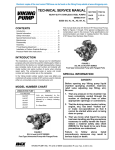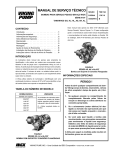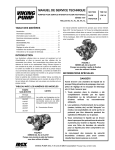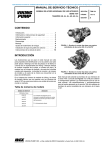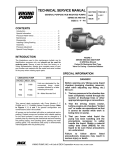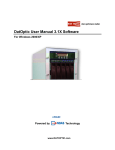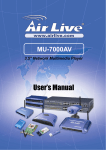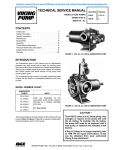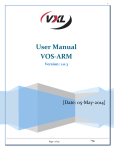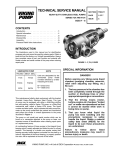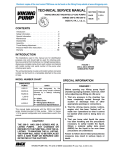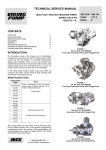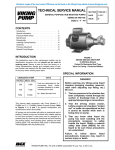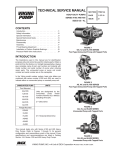Download TECHNICAL SERVICE MANUAL
Transcript
TECHNICAL SERVICE MANUAL HEAVY DUTY STAINLESS STEEL PUMPS SERIES 4197 SIZES GG-AL SECTION TSM 164 PAGE 1 OF 9 ISSUE C CONTENTS Introduction Special Information Special Mechanical Seals Disassembly Assembly Thrust Bearing Adjustment Installation of Carbon Graphite Bushings Pressure Relief Valve Instructions 1 1 2 2 5 7 8 8 INTRODUCTION The illustrations in this manual are for identification purposes only and cannot be used for ordering parts. Obtain a parts list from the factory or a Viking® representative. Always give complete name of part, part number or material with model number and series number of pump when ordering repair parts. The unmounted pump or pump unit model number and serial number are on the nameplate. In the Viking model number system, basic size letters are combined with series number (4197) indicating both uncounted or mounted pump unit. Model Number Chart UMOUNTED PUMPS Foot Mounted GG4197 HJ4197 HL4197 AS4197 AK4197 AL4197 UNITS Units are designated by the unmounted pump model numbers followed by a letter(s) indicating drive style. D-Direct Drive This manual deals only with Series 4197 Heavy-Duty Pumps. Refer to figures 1 thru 15 for general configuration and nomenclature used in this manual. Pump specifications and recommendations are listed in Catalogue Section 164, Series 4197 Stainless Steal Heavy-Duty Pumps. FIGURE 2 AS,AK and AL 4197 SERIES Foot Type Unmounted Pump with Flanged Ports SPECIAL INFORMATION DANGER BEFORE OPENING ANY VIKING PUMP LIQUID CHAMBER (PUMPING CHAMBER, RESERVOIR, RELIEF VALVE ADJUSTING CAP FITTING ETC.) BE SURE: 1. THAT ANY PRESSURE IN CHAMBER HAS BEEN COMPLETELY VENTED THROUGH SUCTION OR DISCHARGE LINES OR OTHER APPROPRIATE OPENINGS OR CONNECTIONS. 2. THAT THE DRIVING MEANS (MOTOR, TURBINE, ENGINE, ETC.) HAS BEEN “LOCKED OUT” OR MADE NON- OPERATIONAL SO THAT IT CANNOT BE STARTED WHILE WORK IS BEING DONE ON PUMP. 3. THAT YOU KNOW WHAT LIQUID THE PUMP HAS BEEN HANDLING AND THE PRECAUTIONS NECESSARY TO SAFELY HANDLE THE LIQUID. OBTAIN A MATERIAL SAFETY DATA SHEET (MSDS) FOR THE LIQUID TO BE SURE THESE PRECAUTIONS ARE UNDERSTOOD. FAILURE TO FOLLOW ABOVE LISTED PRECAUTIONARY MEASURES MAY RESULT IN SERIOUS INJURY OR DEATH. FIGURE 1 GG, HJ and HL 4197 SERIES Foot Type Unmounted Pump with Flanged Ports VIKING PUMP INC. • A Unit of IDEX Corporation • ROTATION: Viking pumps operate equally well in a clock wise or counter clockwise rotation. Shaft rotation determines which port is suction and which is discharge. Port in area where pumping elements (gear teeth) come out of mesh is suction port. SUGGESTED REPAIR TOOLS: The following tools must be available to properly repair Series 4197 pumps. These tools are in addition to standard mechanics' tools such as, open end wrenches, pliers, screw drivers, etc. Most of the items can be obtained from an industrial supply house. PRESSURE RELIEF VALVES: 1. Soft Headed Hammer 1. 2. Allen wrenches (set screw & special mechanical seals) 3. Snap ring pliers INTERNAL - Viking P/N 2-810-047-999 GG-HJ-HL 4197 EXTERNAL - Viking P/N 2-810-029-375 GG-HJ-HL 4197 4. Mechanical seal installation sleeve 2-751-001-900 for ¾ inch seal; GG-HJ-HL 4197 2-810-004-900 for 1¼ inch seal; AS-AL- 4197 5. Bearing locknut spanner wrench Source: #471 J.H. Williams & Co. or equal) 6. Spanner wrench, adjustable pin type for use on bearing housing end cap (Source: #482 J.H. Williams & Co. or equal) 7. Brass bar 8. Arbour press 2. 3. 4. 5. Viking pumps are positive placement pumps and must be provided with some sort of pressure protection. This may be a relief valve mounted directly on the pump, an inline pressure relief valve, a torque limiting device or a rupture disk. There are relief valve options available on these pumps. Relief Valve options include an internal relief valve and a return to tank relief valve. If pump rotation is to be reversed during operation, pressure protection must be provided on both sides of pump. Relief valve adjusting screw cap must always point towards suction side of pump. If pump rotation is reversed, remove pressure relief valve and turn end for end. Pressure relief valves cannot be used to control pump flow or regulate discharge pressure. For additional information on pressure relief valves, refer to Technical Service Manual TSM000 and Engineering Service Bulletin ESB-31. DISASSEMBLY SPECIAL MECHANICAL SEALS DANGER Extra care should be taken in repair of these pumps. Be sure to read and follow all special instructions supplied with your pump. BEFORE OPENING ANY VIKING PUMP LIQUID CHAMBER (PUMPING CHAMBER, RESERVOIR, RELIEF VALVE ADJUSTING CAP FITTING ETC.) BE SURE: RELIEF VALVE ADJUSTING SCREW CAP 1. THAT ANY PRESSURE IN CHAMBER HAS BEEN COMPLETELY VENTED THROUGH SUCTION OR DISCHARGE LINES OR OTHER APPROPRIATE OPENINGS OR CONNECTIONS. SUCTION 2. THAT THE DRIVING MEANS (MOTOR, TURBINE, ENGINE, ETC.) HAS BEEN “LOCKED OUT” OR MADE NON- OPERATIONAL SO THAT IT CANNOT BE STARTED WHILE WORK IS BEING DONE ON PUMP. DISCHARGE 3. THAT YOU KNOW WHAT LIQUID THE PUMP HAS BEEN HANDLING AND THE PRECAUTIONS NECESSARY TO SAFELY HANDLE THE LIQUID. OBTAIN A MATERIAL SAFETY DATA SHEET (MSDS) FOR THE LIQUID TO BE SURE THESE PRECAUTIONS ARE UNDERSTOOD. FIGURE 3 MAINTENANCE Series 4197 pumps are designed for long, trouble free service life under a wide variety of application conditions with a minimum of maintenance. The points listed below will help provide long service. FAILURE TO FOLLOW ABOVE LISTED PRECAUTIONARY MEASURES MAY RESULT IN SERIOUS INJURY OR DEATH. CLEANING PUMP: Keep pump as clean as possible. This will facilitate inspection; adjustment and repair work and help prevent over looking a dirt covered grease fitting. STORAGE: If pump is to be stored, or not used for six months or more, pump must be drained and a light coat of non-detergent SAE 30 weight oil must be applied to all internal pump parts. Lubricate fittings and apply grease to pump shaft extension. Viking suggests rotating pump shaft by hand one complete revolution every 30 days to circulate oil. 1. Refer to figure 7 & 8 page 4 for model to be disassembled and name of parts. 2. Mark head and casing before disassembly to ensure proper reassembly. The idler pin, which is offset in pump head, must be positioned toward and equal distance between port connections to allow for proper flow of liquid through the pump. SECTION TSM 164 ISSUE C PAGE 2 OF 9 3. Remove the head capscrew. NOTE: The four valve capscrews, valve and gasket must be removed from the GG 4197 model before the six head capscrews are removed. 4. Remove head from pump. Do not allow idler to fall from idler pin. Tilt top of head back when removing to prevent this. Avoid damaging head gasket. 5. Remove idler and bushing assembly. If idler bushing needs replacing, see "Installation of Graphite Bushings" page 8. 6. Remove locknut from shaft. See figure 9 or 10. A piece of brass or hardwood inserted in port opening and between rotor teeth will keep shaft from turning. 7. Loosen two setscrews in face of bearing housing and torn thrust bearing assembly counter clockwise and remove from casing. See figure 9 or 10. 8. Remove snap ring from shaft for GG, HJ, or HL size pumps, see figure 9. 9. Remove bearing spacer from shaft for AS, AK & AL size pumps, see figure 9. 10. Remove piece of brass or hardwood from port opening. 11. The rotor shaft can now be removed by tapping on end of shaft with a lead hammer or, if using a regular hammer, use a piece of hardwood between shaft and hammer. The spring and rotary member of the seal will come out with rotor and shaft. 12. Remove inner snap ring and single row ball bearing from casing. See figure 9. The AS, AK & AL size pumps do not have this snap ring. 15. Disassemble thrust-bearing assembly. Remove outer snap ring from bearing housing for GG, HJ or HL size pumps and ball bearing can be removed. See figure 9. 16. The AS, AK and AL thrust bearing assembly has an lip cap and end seal that can be removed after loosening two set screws in flange of bearing housing. Remove ball bearing. See figure 10. The casing should be examined for wear, particularly in the area between ports. All parts should be checked for wear before pump is put together. When making major repairs, such as replacing a rotor and shaft; it is advisable to also in stall a new mechanical seal, head and idler pin and bushing. See "Installation of Carbon Graphite Bushings" page 8. Clean all parts thoroughly and examine for wear or damage. Check lip seals ball bearings, bushing and idler pin and replace if necessary. Check all other parts for nicks, burrs, excessive wear and replace if necessary. Wash bearings in clean solvent. Blow out bearings with compressed air. Do not allow bearings to spin; turn them slowly by hand. Spinning bearings will damage race and balls. Make sure bearings are clean, then lubricate with non-detergent SAE 30-weight oil and check for roughness. Roughness can be determined by turning outer race by hand. Replace bearings if bearings have roughness. Be sure shaft is free from nicks, burrs and foreign particles that might damage mechanical seal. Scratches on shaft in seal area will provide leakage paths under mechanical seal. 13. Remove bearing retainer washer from the AS, AK or AL size pumps. See figure 10. ROTOR 14. With a drift or screwdriver inserted in the shaft end of casing, tap stationary seat from casing. See Figures 11 and 13. IDLER MECHANICAL SEAL HEAD SHAFT IDLER PIN CASING BALL BEARINGS RELIEF VALVE CUTAWAY OF MODELS GG, HJ or HL4197 FIGURE 4 SECTION TSM 164 ISSUE C PAGE 3 OF 9 EXPLODED VIEW MODELS GG, HJ and HL 4197 FIGURE 5 ITEM NAME OF PART ITEM NAME OF PART ITEM NAME OF PART ITEM NAME OF PART 1. Locknut 7. Ball Bearing, Inner 13. Idler and Bushing 19. Relief Valve 2. Snap Ring, Outer 8. Casing 14. Head Gasket 20. Capscrew for Valve 3. Ball Bearing, Outer 9. Pipe Plug 15. Idler Pin 4. Snap Ring for Shaft 10. Mechanical Seal 16. Head and Idler Pin 5. Bearing Housing 11. Rotor and Shaft 17. Capscrew for Head 6. Snap Ring, Inner 12. Idler Bushing 18. Gasket for Relief Valve EXPLODED VIEW MODELS AS, AK and AL 4197 FIGURE 6 ITEM 1. 2. 3. 4. NAME OF PART ITEM NAME OF PART ITEM NAME OF PART ITEM NAME OF PART Lockout 7. Bearing Spacer 13. Pipe Plug 19. Head Gasket Bearing Spacer Collar 8. Ball Bearing Inner 14. Capscrew for Valve 20. Idler Pin 9. Bearing Washer 15. Rotor and Shaft 21. Head and Idler Pin 10. Casing 16. Mechanical Seal 22. Capscrew for Head Gasket for Relief Valve 17. Idler Bushing 23. Pipe Plug Relief Valve 18. Idler and Bushing End Cap of Housing Lip Seal for Housing Bearing Bearing 5. Ball Bearing, Outer 6. Bearing Housing 11. 12. Retainer SECTION TSM 164 ISSUE C PAGE 4 OF 9 INNER BALL BEARING BALL BEARING INNER SNAP RING OUTER SNAP RING LOCKNUT SHAFT SHAFT SNAP RING PREPARATION: Remove burrs from threads and gently radius leading edges on rotor shaft. Use 300 grit paper to radius edges and to polish shaft at seal area. Clean rotor hub, shaft and seal seat bore in casing, making sure they are free from dirt and grit. Place installation sleeve on shaft, wide end against shaft shoulder. See figure 10. STATIONARY SEAT ASSEMBLY: Refer to Figures 9 and 11. BEARING HOUSING SETSCREWS THRUST BEARING ASSEMBLY GG, HJ, HL SIZES FIGURE 7 BALL BEARING SETSCREW INNER BALL BEARING All models-Coat outside diameter of seat ring assembly and inside diameter of seal housing bore with SAE 30 oil. Align slot in back of seal seat with anti-rotation pin in bottom of casing seat bore and start seal seat into this bore. Protect lapped surface of seal seat with a disc of clean cardboard and press seal seat into this bore until it is firmly at the bottom of the bore. A hammer handle or wood dowel will serve to press against the cardboard disc and seat. ASSEMBLY OF SEAL ROTATING PORTION: INNER SNAP RING NYLON INSERT END CAP LIP SEAL BEARING SPACER LOCKNUT BEARING HOUSING SETSCREWS THRUST BEARING ASSEMBLY AS, AK, AL SIZES FIGURE 8 ASSEMBLY TEFLON FITTED MECHANICAL SEAL 1. Installing New Seal: See Figures 9 thru 13. GENERAL INFORMATION: Mechanical seals for HJ, HL, AS, AK and AL4197 size pumps are of the drive set screw type. Mechanical seals for GG4197 size pump are friction driven and are pressed onto rotor hub. Installation sleeves are furnished with replacement seals for GG, AS, AK, size pumps. (this is not necessary with HJ and HL pumps). NOTE: Cleanliness during installation is essential to seal performance. Never allow seal faces to contact a dirty surface. ORDER OF ASSEMBLY: 1. Stationary seat and seat ring in casing 2. Installation sleeve in shaft (where appropriate) 3. Seal rotating portion on rotor and shaft 4. Rotor and shaft into casing 5. Head with gasket and idler casing. PREPARATION: Remove burrs from threads and gently radius leading edges on rotor shaft. Use 300 grit paper to radius edges and to polish shaft at seal area. Clean rotor hub, shaft and seal seat Models HJ, HL, AS, AK and AL4197 (refer to figure 12) Coat inside diameter of rotating portion assembly, shaft and tapered sleeve with SAE 30 weight oil. Be sure shaft is free of axial scratches, nicks and burrs. Check internal parts (Teflon rings and carbon washer) of rotating portion so that parts concentrically aligned so they will not be pinched and twisted at installation. With shaft pointed upward push rotating portion down along large shaft onto the large diameter. Remove holding clips, which hold spring-loaded disc away from Teflon and carbon parts. See figure 10. Push seal against rotor hub and tighten set screws to lock seal to shaft. Remove tapered sleeve. MODEL GG4197 - rotating portion of the mechanical seal for GG4197 size pump does not have set screws to drive it and must depend upon interference fit with the rotor hub. See figure 12. The rotating portion must be disassembled before the retainer. (cartridge containing spring, disc, Teflon wedges and carbon face) can be pressed upon rotor hub. See figure 11. To disassembly rotating portion of the seal compress carbon face and rapidly depress retaining ring through the notch at the end of the retainer cartridge, as shown in figure 15. CAUTION DO NOT ALLOW THE COMPRESSED SPRING TO BE RELEASED SUDDENLY, WHICH MIGHT SEND METAL PARTS FLYING, PROTECT YOUR EYES! PROTECT THE CARBON FACE AND THE TEFLON PARTS FROM DAMAGE OR CONTAMINATION. DISASSEMBLE THE SPRING AND DISC BY REMOVING THE HOLDING CLIPS AROUND THE OUTSIDE. Press retainer cartridge onto other hub. See figure 12. At the factory a tubular installation tube is inserted beside the retainer cartridge when pressing it onto the rotor hub. In lieu of a special tool, a 6 1/2" length of one-inch schedule 40 pipe or some blocks of wood and a light hammer can be used. Lubricate rotor hub with Teflon paste, grease or SAE 30 oil and start retainer onto leading edge of rotor hub as evenly as possible. Lubricate rotor hub with Teflon paste, grease or SAE 30 oil and start retainer onto leading edge of rotor hub as evenly as possible. SECTION TSM 164 ISSUE C PAGE 5 OF 9 Insert one inch pipe into retainer cartridge and press it against the rotor hub, or, with a block of wood in each hand push on outside edge on side to force retainer down the hub. It may be necessary to use a length of hard wood and a light hammer to completely set retainer cartridge against back of the rotor of the rotor. Check dimensionally from end of container to a machined portion on back of rotor at least two places 180º apart. Runout should not exceed 0.003" (the plane formed by the end of the retainer should be perpendicular to the shaft as closely as possible). Clean up and blow out assembly just made. Replace spring and disc. Lubricate the two piece Teflon wedge inside and outside with SAE 30 oil. Place tapered sleeve furnished with replacement seals on shaft against largest shaft diameter and coat it with SAE 30 oil. Push Teflon wedge assembly over tapered sleeve and using carbon washer push wedge onto retainer against disc. Align retainer with carbon washer indents, compress and secure with retainer ring. When carbon face is compressed against spring some "drag" should be felt, but the spring must be able to push the wedge and carbon face out against the retainer ring. COAT SHAFT AND INSTALLATION SLEEVE WITH LIGHT OIL BEFORE ASSEMBLY INSTALLATION SLEEVE HOLDING CLIPS MECHANICAL SEAL (ROTATING PORTION) FIGURE 10 SEAL SEAT BORE CASING ROTOR HUB CASING ROTOR MECHANICAL SEAL FOR GG4197 1. Retainer Cartrige 2. Springs 3. Wedge 4. Rotating face (washer) 5. Stationary Seat 6. Seat Ring (gasket) 7. Disc 8. Retaining Ring 9. Anti-rotation pin SHAFT MECHANICAL SEAL FOR MODELS HJ, HL, AS, AK and AL4197 1. Retainer Cartrige 2. Springs 3. Wedge 4. Rotating face (washer) 5. Stationary Seat 6. Seat Ring (gasket) 7. Anti-rotation pin 8. Drive Set Screws FIGURE 11 RETAINER CARTRIDGE ROTOR GROOVE FOR RETAINING RING FIGURE 9 2. Remove installation sleeve. 3. All models - Flush sealing faces of both rotary member and seal seat with light oil and install rotor and shaft. Push rotor and shaft into casing slowly until ends of rotor teeth are just below the face of casing. Place gasket on head and install head and idler assembly on pump. Pump head and casing were marked before disassembly to ensure proper reassembly. If not, be sure idler pin, which is offset in pump head, is positioned toward and equal distance between port connections to allow for proper flow of liquid through pump. SHAFT TUBULAR INSTALLATION INTERFERENCE TOOL FIT GG4197 SEAL RETAINER CARTRIDGE ON ROTOR HUB FIGURE 12 SECTION TSM 164 ISSUE C PAGE 6 OF 9 4. Tighten head capscrews evenly. 5. If pump was equipped with a relief valve and was removed during disassembly, install on head with new gaskets. Relief valve adjusting screw cap must always point towards suction pump. Refer to figure 3 page 2. For relief valve repair or adjustments, see PRESSURE RELIEF VALVE INSTRUCTIONS, page 8. 6. Pack ball bearing with multi-purpose grease, NLGI #2, and install in casing with sealed towards head end of pump. Install inner snap ring in GG, HJ and HL size pumps. See figure 7. NOTE: AS, AK and AL size pumps do not have a snap ring, a bearing retainer washer must be assembled over end of shaft before the bearing is assembled. See figure 8. 7. Place bearing spacer over shaft and against single row ball bearing in casing (AS, AK and AL size pumps). See figure 8. 8. Install shaft snap ring in groove in the shaft (GG, HJ and HL size pumps). See figure 7. 9. Pack lubrication chamber between inner ball bearing and double row ball bearing in the thrust bearing assembly approximately half full with multi-purpose grease, NLGI #2. See figures 7 and 8. 10. Pack double row ball bearing with multi-purpose grease, NLGI #2 and press into bearing housing with shield side toward coupling end of shaft. See figure 7. (AS, AK and AL size pumps do not use a shielded bearing). Install snap ring to hold snap ring in place on GG, HJ and HL size pumps. NOTE: On AS, AK and AL size pumps, install lip seal in bearing housing end of cap. The lip should face towards end of shaft. Put bearing spacer sleeve in lip seal and install in bearing housing and tighten set screws securely. See figure 8. 11. Insert a piece of brass hard wood through port opening between rotor teeth and keep shaft from turning. 12. Start thrust bearing assembly into casing. Turn by hand until tight. This forces rotor against head. Replace and tighten locknut on shaft. 13. Remove brass piece or hardwood from port opening FIGURE 13 THRUST BEARING ADJUSTMENT See figures 7 and 8. Loosen two screws in face of thrust bearing assembly. If shaft cannot be rotated freely, turn thrust bearing assembly counter clockwise until shaft cannot be turned easily. To set end clearance: 1. While turning rotor shaft, rotate thrust bearing assembly clockwise until noticeable drag occurs (this is zero end clearance). 2. Mark position of bearing housing with respect to the casing. 3. Rotate thrust bearing assembly counter clockwise the distance listed below as measured on outside of bearing housing. 4. Tighten two setscrews in face of bearing housing after adjustment is made to secure thrust bearing assembly position. For viscosity's above 2500 SSU, add additional end clearance (0.005" for GG, HJ and HL size pumps and 0.007" for AS, AK and AL size pumps). 14. Adjust pump end clearance, refer to page 8. DANGER BEFORE STARTING PUMP, BE SURE ALL DRIVE EQUIPMENT GUARDS ARE IN PLACE. PUMP SIZE Distance in Inches on O.D. of Bearing Housing END CLEARANCE GG 11/16" .005 HJ, HL 15/16" .005 AS, AK, AL 11/4" .008 FAILURE TO PROPERLY MOUNT GUARDS MAY RESULT IN SERIOUS INJURY OR DEATH. SECTION TSM 164 ISSUE C PAGE 7 OF 9 INSTALLATION OF CARBON GRAPHITE BUSHINGS LIST OF PARTS 1. 2. 3. 4. 5. When installing graphite bushings, extreme care must be taken to prevent breaking. Carbon graphite is a brittle material and easily cracked. If cracked the bushing will quickly disintegrate. Using a lubricant and adding a chamfer on the bushing and the mating part will help in installation. The additional precautions listed below must be followed for proper installation: 1. A press must be used for installation. 2. Be sure bushing is started straight. 3. Do not stop pressing operation until bushing is in proper position, starting and stopping will result in cracked bushing. 4. Check bushing for cracks after installation. PRESSURE RELIEF VALVE INSTRUCTIONS Valve Cap Adjusting Screw Locknut Spring Guide Bonnet 6. 7. 8. 9. 10. Valve Body Valve Spring Poppet Cap Gasket Bonnet Gasket DANGER BEFORE OPENING ANY VIKING PUMP LIQUID CHAMBER (PUMPING CHAMBER, RESERVOIR, RELIEF VALVE ADJUSTING CAP FITTING ETC.) BE SURE: 1. THAT ANY PRESSURE IN CHAMBER HAS BEEN COMPLETELY VENTED THROUGH SUCTION OR DISCHARGE LINES OR OTHER APPROPRIATE OPENINGS OR CONNECTIONS. 2. THAT THE DRIVING MEANS (MOTOR, TURBINE, ENGINE, ETC.) HAS BEEN “LOCKED OUT” OR MADE NON- OPERATIONAL SO THAT IT CANNOT BE STARTED WHILE WORK IS BEING DONE ON PUMP. 3. THAT YOU KNOW WHAT LIQUID THE PUMP HAS BEEN HANDLING AND THE PRECAUTIONS NECESSARY TO SAFELY HANDLE THE LIQUID. OBTAIN A MATERIAL SAFETY DATA SHEET (MSDS) FOR THE LIQUID TO BE SURE THESE PRECAUTIONS ARE UNDERSTOOD. VALVE - GG, HJ, and HL SIZE FIGURE 14 LIST OF PARTS 1. 2. 3. 4. 5. Valve Cap Adjusting Screw Locknut Spring Guide Bonnet 6. 7. 8. 9. 10. Valve Cap Adjusting Screw Locknut Spring Guide Bonnet FAILURE TO FOLLOW ABOVE LISTED PRECAUTIONARY MEASURES MAY RESULT IN SERIOUS INJURY OR DEATH. Mark valve and head before disassembly to ensure proper reassembly. 1. Remove valve cap. 2. Measure a record length of extension of adjusting screw. Refer to "A" on Figure 14 and 15. 3. Loosen locknut and back out adjusting screw until spring pressure is being released. 4. Remove bonnet, spring guide, spring and poppet from valve body. Clean and inspect all parts for wear and damage and replace as necessary. VALVE - AS, AK, and AL SIZE FIGURE 15 SECTION TSM 164 ISSUE C PAGE 8 OF 9 TECHNICAL SERVICE MANUAL HEAVY-DUTY BRACKET MOUNTED PUMPS SERIES 4197 SIZES GG - AL SECTION TSM 164 PAGE 9 OF 9 ISSUE C ASSEMBLY Reserve procedures outlined under Disassembly. If valve is removed for repairs, be sure to replace in same position. Relief valve adjusting screw cap must always point towards suction valve of pump. If pump rotation is reserved, remove relief valve and turn end for end. Refer to figures 1 and 2 page 1. DANGER BEFORE STARTING PUMP, BE SURE ALL DRIVE EQUIPMENT GUARDS ARE IN PLACE. FAILURE TO PROPERLY MOUNT GUARDS MAY RESULT IN SERIOUS INJURY OR DEATH. PRESSURE ADJUSTMENT If a new spring is installed or if pressure setting of pressure relief valve is to be changed from that which the factory has set, the following instructions must be carefully followed. 1. Carefully remove valve cap, which covers adjusting screw. Loosen locknut, which locks adjusting screw so pressure setting will not change during operation of pump. 2. Install pressure gauge in discharge line for actual adjustment operation. 3. Turn adjusting screw to increase pressure and out to decrease pressure. 4. With discharge line closed at a point beyond pressure gauge, gauge will show maximum pressure valve will allow while pump is in operation. IMPORTANT In ordering parts for pressure relief valve, always give model number and serial number of pump as it appears on nameplate and name of part wanted. When ordering springs, be sure to give pressure settings desired. VIKING PUMP INC. • A Unit of IDEX Corporation • WARRANTY Viking warrants all products manufactured by it to be free from defects in workmanship or material for a period of one (1) year from date of startup, provided that in no event shall this warranty extend more than eighteen (18) months from the date of shipment from Viking. If, during said warranty period, any products sold by Viking prove to be defective in workmanship or material under normal use and service, and if such products are returned to Viking’s factory at Cedar Falls, Iowa, transportation charges prepaid, and if the products are found by Viking to be defective in workmanship or material, they will be replaced or repaired free of charge, FOB. Cedar Falls, Iowa. Viking assumes no liability for consequential damages of any kind and the purchaser by acceptance of delivery assumes all liability for the consequences of the use or misuse of Viking products by the purchaser, his employees or others. Viking will assume no field expense for service or parts unless authorized by it in advance. Equipment and accessories purchased by Viking from outside sources, which are incorporated into any Viking product, are warranted only to the extent of and by the original manufacturer’s warranty or guarantee, if any. THIS IS VIKING’S SOLE WARRANTY AND IS IN LIEU OF ALL OTHER WARRANTIES, EXPRESSED OR IMPLIED, WHICH ARE HEREBY EXCLUDED, INCLUDING IN PARTICULAR ALL WARRANTIES OF MERCHANTABILITY OR FITNESS FOR A PARTICULAR PURPOSE. No officer or employee of IDEX Corporation or Viking Pump, Inc. is authorized to alter this warranty. VIKING PUMP INC. • Copyright© 2000 •









